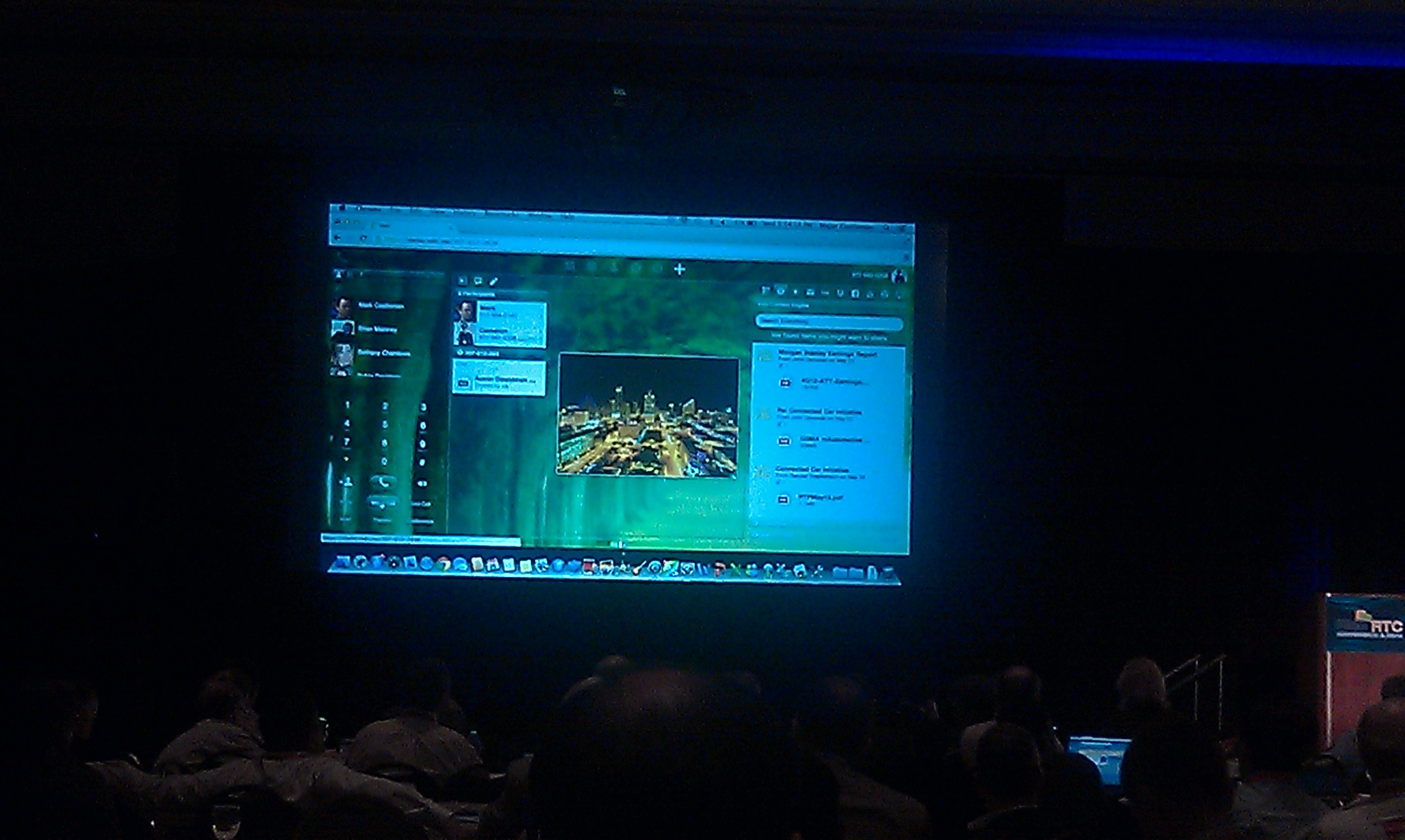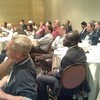Atlanta, GA -- The second evening of WebRTC demos are kicking off with hundreds of attendees eagerly waiting to see what they might be able to do with WebRTC's browser-to-browser communications.
Here is Paula Bernier's coverage of last night's demos:
Solaborate started off the presentations: check out my article on the launch of its WebRTC-based social platform. Today, they've added screen and content sharing as well as group video calls. I have received a beta code (along with @alwaysonCarl) -- we'll be testing the experience shortly, so look for that.
-----
TokBox is showing its video collaboration capabilities. 
"There is nothing speacial about this app -- it's all about delivering a kick-ass experience," says Ian Small, TokBox CEO.
He says it's about solving real use cases. This morning, during his keynote, Small showed a WebRTC app that allowed travel agency customer service staff to bring managers into a call in real-time without sacrificing the experience on either end of the call.
-----
Bistri claims to be one of the most complete WebRTC solution sets.
He is setting up a video call -- it seems to be more complicated than it should be, and the screen is very busy -- though once the call is connected, it can be isolated from the rest of screen for a very simple look and feel.
He is now showing the screen sharing capabilities.
-----
Presence Technology is up now to show its WebRTC-based agent client for its cloud-basd contact center. The flexibility of a cloud-based contact center platform is increased with the benefot of a WebRTC agent desktop -- though they get the same experience with a deskphone or browser.
It's a full multi-channel contact center that can be extended out to the enterprise for a full UC experience. He wasunable to get the demo running, but asked attendees to stop by the booth for a full demo (smart strategy).
/////
Weemo is a B2B cloud service providing real-time video API for Web, mobile, and desktop apps. A Weemo partner has integrated the capabilities into its enterprise social software.
They are showing the first of two demos, which shows a two-party video. The video is quite small and difficult to view.
He is now showing an example of a point-to-point call with one end WebRTC (the other is running on a Safari broswer), then adding two additional users on a Zimbra mail client. Adding users and then connecting them to the original call seemed a bit more tedious than it should. But the quality and collaboration capabilities were smooth and simple.
////
65% of developers responding to Dialogic's WebRTC survey said they need help with interoperability (I'm surprised the other 35% think they have the interop part right).
Dialogic has a three-party conference going on with three different clients:
--iPad withSIP Bria client
--Mac Book with Firefox
--HP laptop running Chrome
Now they've added streaming video to the collaboration experience as well with the click of a button. Recording is also done with the click of a button -- as is playback of the recorded video (either in full screen mode or as part of the collaboration screen).
It's all about looking at transcoding of different codecs, integrating rich media, and interop with different broswers and clients.
Dialogic wrapped up to a strong ovation from the audience. It seems interop is, indeed, a concern.
----
Mavenir Systems is up next with a WebRTC 911 demo with its rich media gateway. Often, first responders would benefit from being able to see what the situation is -- dispatcherswould be better able to ensure the appropriate responders and equipment are sent, and that they are prepared when they arrive on site.
It's about a seamless interaction between Web and traditional communications.
----
Daitan Group takes the stage to talk about WebRTC and IMS -- and why they are relevant to each other. A quick audience survey reveals that Skype and landline phones are both used by the majority of attendees, showing the need for integrating existing infrastructure and OTT services with the WebRTC experience.
If you don't already know about IMS, youprobably don't need to, he notes, drawing a chuckle from much of the crowd. He also notes that this is a technology demo, so they did not spend time "making the interface look pretty."
The video conferencing was failry straight forward, but the screen sharing was unclear, as it appeared in a separate window and did not look like it was acutall being shared with both parties.
----
Alcatel-Lucent says the key problems facing the communications industry are that communications should be multi-modal, that information is scattered, and that services remain siloed.
Part of a quality experience is being able to manage content, move in and out of modes, share and unshare content -- really create a customizable experience. It's about adding context to the call, and turning each call into an asset.
The same holds for the mobile experience, which they say is not about the device, but the interaction and the user experience.
This was one of the more attractive demos of the evening so far.
----
vLine's Ben Strong explains his cpompany has developed a production WebRTC platform as a service during the past two years. It provides session management, messaging, UI widgets (WebRTC doesnt provide much in the way of UIs), pluggable authentication.
He called Dave from Bloc -- one of vLine's first clients -- which uses vLine every day for its business. He says it's a great experience, which replaced a larger more popular service that crashed often and created more difficulties that it was worth. He says they have no issues with the vLine product.
For multi-party calls, the system uses speaker recognition capabilities to bring the speaking party to the large screen.
(They are having problems getting Kevin into the conversation, so they added Tom, who is also here at WebRTC Expo to the call).
----
Sansay's demo focuses on the WebRTC integration into its SBC, helping operators handle transcoding, interworking, encryption/decryption for traffic at their network edges. The demo includes presence, voice, video, and data channel.
They start with a WebRTC to WebRTC session, connecting through a Web SBC on the West Coast. Then they’re doing an off-Net call between SIP and WebRTC. His first call went unanswered -- and to the amusement of the audience, his laptop battery ran out of juice as he tried to continue.
----
Instant Solutions is on the stage to talk about its scalable instant contact center -- but not before giving away one of the four Brasilia football jerseys they brought with them.
I'm having a difficult time understanding the next slide in Spanish.
Their demo call is going through a SIP Trunk to Sao Paolo, and eventually finally rerouted back to the demo stage here in Atlanta.
The next jersey giveaway was to the first two who dialed into a toll-free number. Presumably, it was into a WebRTC-enabled endpoint, but that was at best unclear.
----
Symonics had some nice-looking headphones at its booth and is next to demo. The company is about high-quality spacial audio -- 3D audio, coming from the left/right, front/back, and top/bottom. He talked about the audio system in the Porsche 911 (I don't think it's WebRTC related, but it is a very nice car).
Getting down to business, he starts talking about spacial audio for conferencing systems. The spacial headsets have sensors that can sense change of direction of the speakers, creating a higher quality, clearer experience.
----
Startup business BitAction showed a demo with a very quick connection, but also the ability to shut down the server without disconnecting the call. Their SDK is what allows the reliable, quick connections to mobile devices
----
Vonage may seem like an odd participant, but it uses WebRTC for its mobile app. There isn't much to it -- the service works -- but the neat part is this is really the first established company to demo here that is using WebRTC in its service offerings.
----
Xirsys' WebRTC offering includes: cloud-based STUN and TURN servers, a simple complete messaging layer, flexible CDN options, simp[le but extensive client API, free to enterprise models, analytics capabilities, and securie implementation.
The client API is simple yet flexible, supporting video, audio, and the data channel, screensharing, user management APIs, customer authentication, and and extensible events framework.
----
Browsetel (an seemingly appropriate brand for a WebRTC comms business), leads with its tagline, "Simplifying Communications," which seemed to permeate its displays, features, and overall platform.
----
Quobis has been in the UC space since 2006, with a focus on VoIP security and interconnection for both enterprise and SP markets. (It would have been fun if the Spanish company had given away David Villa jerseys to compete with Instant Solutions.)
Its Sippo product is designed for the enterprise market, with address book featutres, provisioning API, presence, privelege manaement, and CDR integration.
The most interesting part of the demo was the very short use of Sippo embedded in a website -- this is going to be a huge WebRTC use case.
----
Voxeo Labs works on desktop Chrome and Firefox, but also Safari and IE via Flash, and has mobile Chrome and FF in progress at the moment. It also provides an open source API and supports as many standards as anyone in its efforts to be as flexible a WebRTC alternative as possible.
Its motivation is making the integration of WebRTC simple so developers can get on with their apps.
He showed about 6 lines of code that enabled a basic call to be placed -- much less work than many developers are tasked with (then proceded to accidentlaly dial the front desk of the Sheraton Hotel -- generating generous laughter from the audience). But the call went through, which was the point.
Virtual training is going to be a significant use case for WebRTC according to Voxeo Labs, along with healthcare and insurance. The demo included a number of live use cases with attractive interfaces, which will be a key to driving use among end-users.
----
Bolder Thinking sports a no-hardware, cloud-based telephony solution, which, in iteslf isn't exactly unique. It focuses on customer experience, including a speech rec engine running behind the scenes on a consumer focused website. The enguine wasnt able to provide an answer to the question asked, so it forwarded the interaction to a call center agent.
The live agent also is delievered a full customer activity history (in this case, it's a hospitality industry example, so the history includes hotel stays, often useful information for providing a high-quality service).
Bolder Thinking says it can deliver all the features of other vendors, but prefers to focus on the customer to ensure an optimal experience during the interaction with the contact center.
----
Now it's up to the audience... the votes are being tallied.
My vote is for Solaborate. It was one of the few who presented an interesting use case (Bolder Thinking and a few others did as well), but I do believe enterprise collaboration platforms need improvement, but with the right enhancements, should play a major role in creating the true nexct gen enterprise.
The votes are in. The audience favorite is vLine.
Congratulations to Ben Strong.













Leave a comment